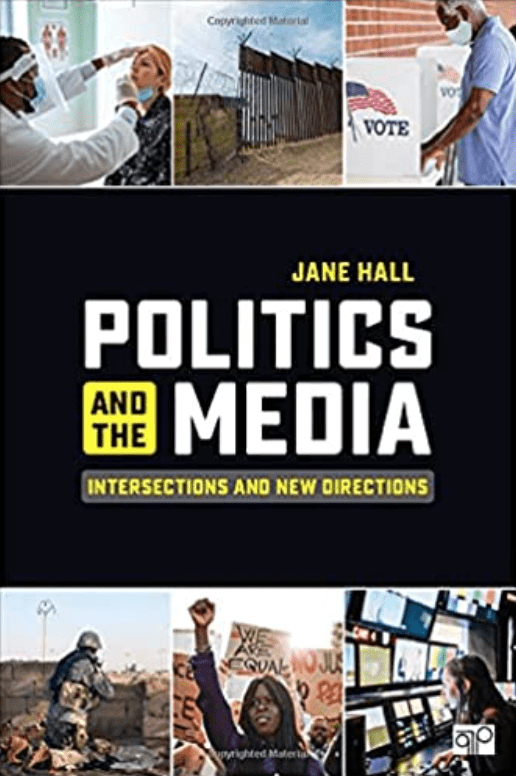“Are We There Yet?”: The Path Forward for Women in Politics

Just over a month ago in November, Michelle Wu was sworn in as the first woman and person of color elected as Boston’s mayor. This was a historic moment, one that certainly raised the bar as a precedent for more women to take higher positions of elected office in the future across America. But how much longer will we have to wait for moments like this to no longer be a rarity? When will we know that women have ‘made it’ in politics?
Jane Hall‘s latest book examines these questions at the crosshairs of journalism and media studies. An associate professor of communication at American University, Hall’s book Politics and the Media: Intersections and New Directions was published with SAGE in August and celebrated with a joint webinar and book launch at the end of September. Hall numerous interviewed television reporters and politicians, discussing history, race, and gender through the 2020 presidential election and beyond.
Hosted by the American University School of Communication and moderated by Betsy Fischer Martin, executive director of the Women & Politics Institute, the event – aptly named “’Are We There Yet?’: Progress and Challenges for Women in Politics and Media” – invited Jane Hall to share space and conversation with journalist April Ryan, a White House Correspondent for theGrio, who has previously spent 24 years covering the White House for American Urban Radio Networks and authored several books including Under Fire and The Presidency in Black and White.
Prefacing Hall’s discussion of her book, Ryan discussed the business of media and politics, drawing on her own experiences as a reporter.
“Not going to sugarcoat it, but we are not ‘there yet’” Ryan said. “This is a business. It is not only male, it is white male. From the inception of reporting on the facts and the White House, what have you, it’s been a network of men coming together …. We have charted a course to make change but [we’re not there yet].”
Specifically, according to Ryan there was a “definite pushback” during the last administration. On how she persevered through the Trump press room, Ryan recalled not only having a tough skin, but an awareness of who she was as part of an underserved community that kept her going. Her advice for young journalists?
“If you want to get into this business, know what you’re getting into,” Ryan said. “There’s always been retaliation … but it’s gone to the nth degree now, farther than we’ve ever anticipated.”
It is exactly that reason why Ryan turned to praise Hall, and her work in educating future journalists and politicians alike.
“Thank you for teaching the next generation that will take our space,” she said, citing Hall’s dedication to education with her new book. “They need to carry the ball forward because these questions need answers.”
Hall’s book comes at a fraught time for media and politics, seeing how press freedom has been ‘twisted’ during the last administration with Trump’s promotion of ‘fake news.’ Suddenly journalists have found their facts being challenged simply due to the fact that some do not agree with the politics being reported, and taking truth-determinism into their own hands, without even considering the matter of race and gender that has led to a further disrespect of women reporters of color like Ryan.
“[As journalists] We are not at war; we are at work,” Hall said, citing Washington Post editor Marty Baron. “We go back to the facts but we’re not stenographers–– 99% of people say this but giving both sides equal say is not freedom of the press.”
Like Ryan, Hall agreed that an important tenet of journalism is the commitment to elevating a variety of voices in reporting, to expand the demographics of political journalism beyond white men. Hall says that in politics and the media, being the first and only is problematic; but once you move past that, you are open to an entirely new perspective.
“Once you have a whole presidential debate with women on the stage, without stereotyping,” Hall said, “you get questions form a range of reporters that you wouldn’t get from a range of backgrounds, be it race, class, region, etc.”
But simply having coverage isn’t enough to be deemed progress––challenges still exist, even after moving past the most blatantly sexist focus on women in politics, such as calling Sarah Palin a ‘hottie’ or giving Hillary Clinton’s debate pantsuits nearly as much attention as Clinton herself.
“The focus on hair and hemlines and voice are all gendered treatments of women and I think we’ve moved past the worst yet we still have a ways to go,” Hall supposed, “but there is still disproportionate discussion of women’s personalities [in comparison to men].”
It’s true: a project done by Northeastern University studying the 2020 presidential election found that among 1400 news stories during the election cycle, there was less coverage on policy and more on personality when it came to female candidates. Education was also found to be a feminine-classed subject, while defense and budget were more masculine-coded. Furthermore, whenever women in power received negative attitudes, those moments continued to be aired on television, whereas they would likely be cut for men.
“There are a record number of women running right now for the House and Senate,” Hall mentioned, “which is good and bad news, but the presidency still is what Pat Schroeder called the “ultimate treehouse” and reflects a lot on how we define power and stereotype women.” As an example, Hall dove into a case study on Elizabeth Warren.
“[Warren] was depicted as another Hillary Clinton,” Hall argued. “She was highly capable and had lots of plans, but the attitudes we have towards women who are ambitious and highly prepared [is that] they are ‘punished’ for being competent.”
When Martin commented that she’s “never met a non-ambitious politician,” Hall chimed in with a resounding “Exactly!”
“Women’s voices are different from men, but we’ve defined authority [and] ambition as male,” Hall said. “No one’s asking male politicians about the kids or who’s working or about being a tough boss.”
Turning to Vice President Kamala Harris as another example of a woman in power bearing the brunt of misogyny turned towards her in the media, Hall described all of the hate speech online, and all of the the vicious, ugly, racist, sexist tropes against her. She theorized that Harris is suffering from what she calls the “glass cliff” –– handed a portfolio she probably couldn’t win with once she assumed her position of power. Despite the challenges, there was a surge of collective strength around Harris when she was announced as Joe Biden’s pick for vice president, when for a moment a lot of women-aligned organizations stood up to speak out against sexist coverage. While that collective action was important, Hall said that the bad news was that at some point, a publication likened the competition leading up to the announcement for Biden’s vice-presidential pick as a reality show.
“It’s not a reality tv show, not who gets the rose or the prize. We’re talking about deep seeded notions about who gets to be in power, at a time when misogyny is still alive and well more than ever,” Hall argued. “Women were all floated into the media as potential candidates but then torn down by media and other nominees as well because Biden forecasted them. They floated women out as a test and it looked like they were having a catfight, reinforcing this trope in media. How would it play out if you flipped it with men?”
The media’s misogyny does not end with Democrats, as Hall pointed out: Republican women are no exception. Considering Elizabeth Dole, Hall assessed that she was “given a fair shake” and treated “pretty fairly” at first, but over time, the same tired tropes extended to her coverage as well. There was excessive coverage on her pantsuits and on how controlling she was, but when she did a press conference one time, people said she was unprepared on foreign policy, and she retreated. Hall attributes that to the fact that women are more sensitive to the fact that they’re expected to know everything while their male opponents are not.
“GWB was a “regular guy” who lacked experience,” Hall recalled, “and Trump more so but the media said ‘it’s okay, they can learn!’” Meanwhile, when interviewed, Elizabeth’s husband Bob Dole mentioned that he had considered donating to John McCain, who was running against his wife.
Looking ahead to future elections, Hall discussed the possibilities of social media as a double-edged sword for women in politics. On one hand, without needing to go through the filter of media studios, women can get their stories out and control their own narrative, much like Alexandria Ocasio-Cortez (AOC).
“Like an influencer, she’s very savvy with social media, very astute,” Hall praised. “She’s managed to talk about policy while seeming to be relatable, and has managed to get policy before a lot of people, like Marjorie Taylor Green.”
However, the pitfalls of social media fame are just that: politicians must face the same concerns of social media that everyone else does, including the challenge of authenticity, the backlash from haters, the vitriol from peers online, and the potential of endless hate, as many women of color who challenged Donald Trump still continue to receive.
Looking forward, 2022 will be a midterm election year, with all 435 seats in the House of Representatives and 34 of the 100 seats in the Senate being contested. Thirty-nine states will also have local elections at various levels. With a new wave of elections and women entering the races at a more visible level again, Hall left some words of advice moving forward, whether you be a journalist, politician, student, or voter:
“Encourage people to always read the whole story, and to know their sources. Learn not to be judgmental about where you get your news, but always about spreading fake news. And as always, support your local newspapers to be accountable on a local level.”

















































































